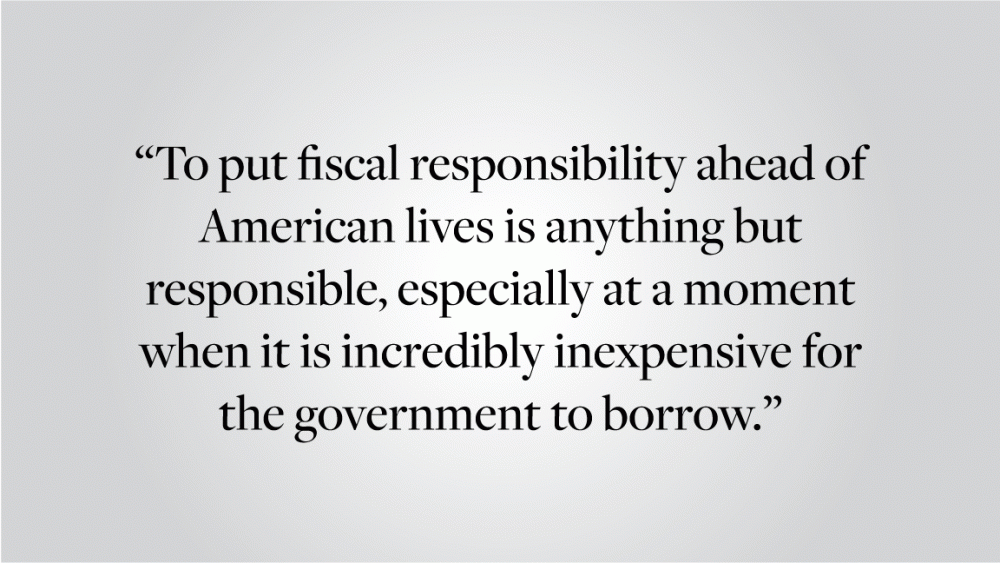In her righteous crusade for the Green New Deal, a $10 trillion dollar spending package meant to address climate change and its disastrous effects, there is one question that Rep. Alexandria Ocasio-Cortez (D-NY) can’t seem to escape.
“How are you going to pay for it?”
In a country facing a yearly spending deficit over $3 trillion dollars, the reality is that the government wouldn’t pay for it for quite a while – it would borrow. Indeed, the largest federal government efforts of the past two decades were carried out on credit. Staring down the greatest post-war threat to American national security since the Cold War, lawmakers spent trillions of dollars that America didn’t have to fund the war on terrorism. Facing economic collapse in 2009, Washington intervened with the American Reinvestment and Recovery Act, boosting spending and cutting taxes to spur hiring and investment.
It’s obvious that Americans are worried about the country’s growing national debt; 83 percent view it as an important issue. Just five minutes from Times Square, the issue quite literally hangs over New Yorkers’ heads in the form of an art installation. Yet the United States today faces challenges as daunting and expensive as ever before, from climate change to COVID-19, that will make it necessary for the government to fill gaps in employment, demand and investment. In this light, the national debt feels even more impossible to pay down.
Americans fear that the national debt threatens their pocketbooks, but crises such as climate change and COVID-19 threaten their lives. Our obsession with the deficit, in other words, is counterproductive. In a world of low interest rates, where dollar denominated assets are still the gold standard, the federal government needs to intervene to solve the era-defining problems of the 21st century, even if it means taking on more debt.
Borrowing is historically cheap in this nation – and world – of low interest rates. In the wake of the 2008 financial crisis, the Federal Reserve set rates at rock bottom levels, hoping to catalyze hiring, borrowing and investment in an economy where all three were anemic. Since then, interest rates haven’t strayed far from zero, and that isn’t likely to change until 2023. On an even longer time horizon, the aging of America’s population means that the trend is likely to continue, as older savers drive growth in the supply of cash to loan out.
Most of the money that the government owes is in the form of Treasury securities, meaning that it benefits from low interest rates and can cheaply maintain its debt. But that isn’t the only reason that low interest rates should dispel worries about Uncle Sam’s credit binge. When they are lower than the rate at which an economy grows, debts shrink over time relative to the size of the economy. This is the norm in the United States, adding a new dimension to a political refrain that is constant, but lacks nuance: “the debt will eventually come due.”
Even worries that the United States’ supply of cash could run out are unfounded. Because U.S. dollars dominate transactions across the global financial system, foreign investors are likely to demand treasury securities for the foreseeable future. Additionally, America’s credit-worthiness precludes a scenario where creditor’s suddenly call their loans in a panic. Nobel Prize-winning economist Esther Duflo has gone so far as to conclude that the federal government’s current debts will likely never have to be repaid, as refinancing prior debts is easy given insatiable demand for dollar-denominated assets.
But perhaps the best arguments against the deficit hawk point of view are the crises that have demanded the federal government’s fiscal attention. If, for instance, Congress had prioritized a balanced budget in their response to the 2008 financial crisis, there simply wouldn’t have been enough money to compensate for universally weak demand. By cutting taxes and increasing expenditures instead, the government reignited growth and boosted employment. European countries took a different path: austerity. But by cutting spending, one estimate finds that the continent sustained a contraction equivalent in magnitude to the entirety of Spain’s economy.
Climate change is yet another existential danger so large and looming that only the government has the fiscal firepower to fix it. A report from 2018 predicts heat-related deaths, more frequent droughts and rising sea levels that will threaten coastal population centers. To put fiscal responsibility ahead of American lives is anything but responsible, especially at a moment when it is incredibly inexpensive for the government to borrow.
Still, the immediate fiscal attention demanded by these crises is no excuse for irresponsibility in times of prosperity. Low interest rates or not, larger piles of debt are more expensive to maintain; ours costs $482 billion per year at last count. By this standard, the Tax Cuts and Jobs Act is grossly irresponsible: It was targeted mainly at the wealthy, born in the thick of an economic expansion and it drove up the deficit by a trillion dollars. The legislation cut taxes for the wealthy at a time when businesses and investors already had record levels of confidence in their economic prospects. In periods of growth, fiscal caution should once again take hold.
Never before in history has a country had the borrowing capacity of the United States. If our government is to continue being a leader in the battle against global challenges that threaten human life, it needs to take advantage of that.
Arjun Shanmugam ’23 can be reached at arjun_shanmugam@brown.edu. Please send responses to this opinion to letters@browndailyherald.com and op-eds to opinions@browndailyherald.com.

ADVERTISEMENT


